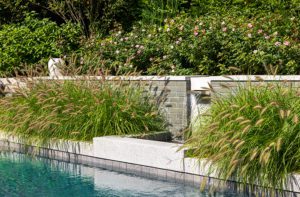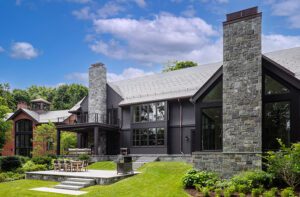Greek Revival-Style Meets Energy Efficiency
March 5, 2024
Energy saving advances are embraced in classic style, inside and out.
Text by Gail Ravgiala Photography by Michael J. Lee Produced by Karin Lidbeck Brent
Traditional design meets net-zero technology in a new house on a quiet suburban street west of Boston. But while passersby can admire the classic nineteenth-century Greek Revival-style architecture, and visitors can take in the mid-twentieth-century-modern aesthetic of the interior, the twenty-first-century building techniques and products that make the structure a model of energy efficiency are hidden from view.
“Although this house is most advanced in terms of green building, we used architectural details that people would recognize,” says architect J.B. Clancy of ART Architects. Set in a neighborhood of 1930s Tudor and Colonial Revival houses, the new structure is quietly compatible in style and scale.
The house gets to net-zero—that is, its annual energy consumption is less than or equal to the amount of energy it generates—without fanfare. There are no bells and whistles attached to the energy-saving elements, just the unseen protection of the thermal blanket that envelops the frame like a snug down parka. Continuous super insulation mitigates “thermal bridging,” which occurs in conventional buildings when a lack of insulation at corners, joints, windows, and doors allows heat to escape. “We create an environment where no air comes in and out,” says Mathew Roth of Hawthorn Builders. To ensure there is adequate ventilation, an energy recovery system exchanges fresh air for stale while extracting energy in the process.
Heating and cooling are provided by a Mitsubishi air-source pump powered with electricity generated by the solar panels on the roof, which is angled for optimal southern exposure. In fact, the entire house is sited so that living spaces face south for passive solar advantage.
Inside, the design reflects the homeowners’ commitment to efficiency—energy and otherwise. The empty-nest couple primarily occupies the first-floor living room, kitchen, and primary suite, reserving the four second-floor bedrooms for guests. “With limited space, function is key,” says interior designer Leslie Fine. “Every room has a use, which mimics the idea of net-zero.”
Though the marketplace is moving toward green building, it is not mainstream, says Roth. “There are costs involved in building a super-insulated house, but they are reduced in savings over time,” he says. “We have an opportunity to educate people why these practices are good for the environment and for the people living in the house.”
Project Team
Architecture: ART Architects
Interior design: Leslie Fine Interiors
Builder: Hawthorn Builders
Landscape design: Offshoots
Share
![NEH-Logo_Black[1] NEH-Logo_Black[1]](https://b2915716.smushcdn.com/2915716/wp-content/uploads/2022/08/NEH-Logo_Black1-300x162.jpg?lossy=1&strip=1&webp=1)


















You must be logged in to post a comment.